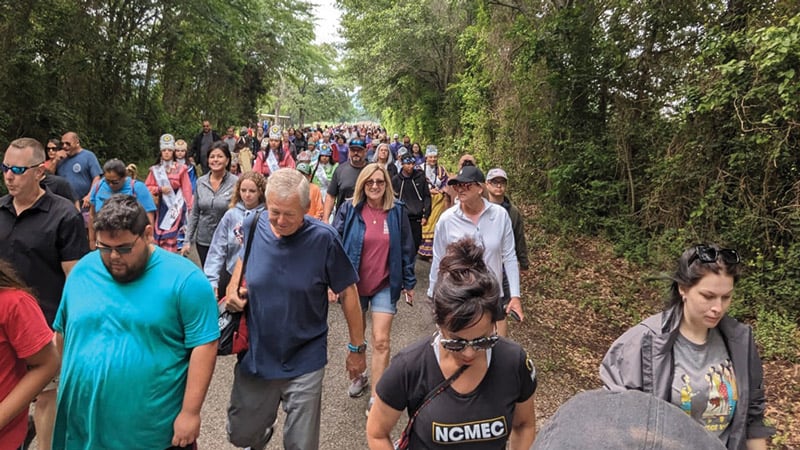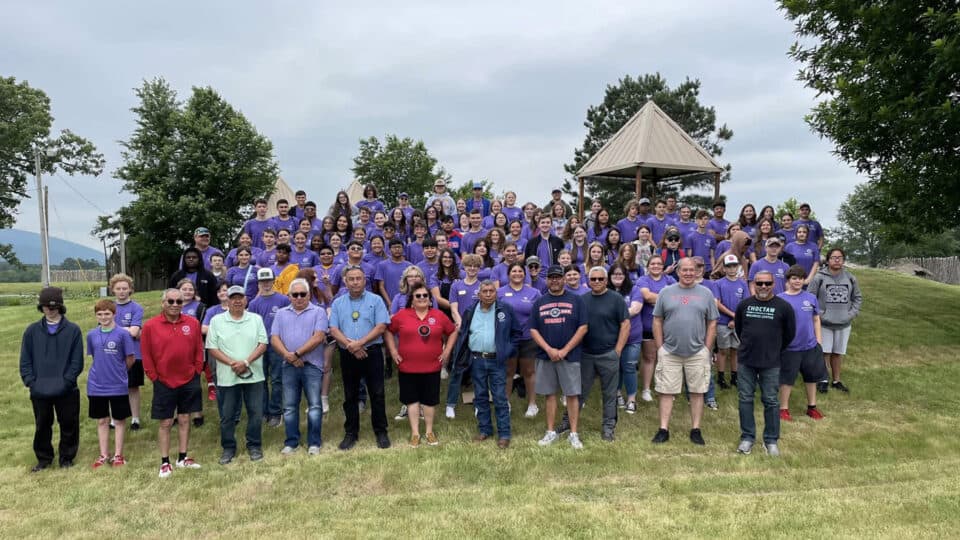
The 2023 Choctaw Nation Trail of Tears Cycling Team after completing the 500-mile ride from Mississippi to Oklahoma. (Left to right) William Nachand, Tina James, Colton James, Arianna Myers, Dr. Lena (Nikki) Eagle Road, Teresa Eagle Road, Billy Eagle Road III, Steve Clark, Scott Lambert, Beckah Boykin and Jana Boykin.
The Trail of Tears: Why we remember
Published July 5, 2023The Choctaw people were forcibly removed from their homeland 193 years ago. From 500-mile bike rides to memorial walks, descendants of the people who made that fateful journey remember the strength and sacrifices of their ancestors in their own way.
The Choctaw were the first of the southeastern tribes to experience Removal.
The Trail of Tears for the Choctaw people began years before the first steps of physical removal.
Coordinated efforts of the U.S. government to claim Choctaw tribal lands east of the Mississippi River started as early as 1801. From 1801 to 1820, Choctaws ceded 25,000 square miles of homelands to the U.S. government.
The Treaty of Dancing Rabbit Creek negotiations in 1830 were full of deceit and coercion. Choctaw leaders were told their remaining homelands would be taken from them whether they signed the treaty or not.
Choctaw leaders were warned that if the treaty was not signed, the United States would seize Choctaw lands, the U.S. military would destroy any resistance and the Choctaw people would be moved west by force.
According to the United States government, Choctaws would be destroyed.
With no options left, the Choctaw leaders were forced to sign the treaty to secure any lands at all.
The Choctaw Nation was forced to give up the remaining one million acres of the homeland and move to Oklahoma.
“We go forth sorrowful, knowing that wrong has been done. Will you extend to us your sympathizing regards until all traces of disagreeable oppositions are obliterated, and we again shall have confidence in the professions of our white brethren.”
– Chief George Harkins
The Treaty of Dancing Rabbit Creek became the largest land cession treaty signed to date by the U.S. government and was the first removal treaty put into effect under the Indian Removal Act.
On May 28, 1830, President Andrew Jackson signed the Indian Removal Act.
This law relocated Indian nations westward to unsettled lands in what are now the states of Kansas and Oklahoma. Among those forced to move were the Choctaw, Cherokee, Creek, Seminole, and Chickasaw tribes, still known today as the Five Civilized Tribes.
Choctaws were organized into three districts in their homeland. When it came to the Removal, most Choctaws moved with local leaders who decided which district leader to follow, resulting in numerous waves of Removal.
For Choctaws, the Trail of Tears would last for more than 70 years, with groups being removed from the Choctaw homeland to Indian Territory up until 1903. The biggest group made the journey in 1830-1834. Some Choctaws remained behind in their homeland, opting to live under discriminatory Mississippi law.
The U.S. government had agreed to provide plenty of food for the journey, transportation by wagon or steamboat and food for up to one year after settlement in the new lands.
Poor communication and coordination of Removal efforts by the U.S. government combined with cost-cutting, delays, severe winter weather and disease made the journey immeasurably different from what was promised.
Approximately 15,000 Choctaws made the trip between 1831 and 1833. One-quarter to one-third perished from disease, starvation, exposure and murder. They called it a “Trail of Tears and Death,” a name that would later be used for the Removal of other southeastern tribes.
The appalling conditions, broken promises by the U.S. government and the loss of leaders, elders and children demoralized the Choctaw people.
The last wave of the Choctaw Trail of Tears occurred in 1902 and 1903. Some of these individuals were brought to Ardmore, Oklahoma, by Euro-American speculators who intended to sell them into slavery. Many died from mistreatment. Today, the surviving descendants of this Removal have “Mississippi Choctaw” on their CDIBs.

Riders, escorted by Tribal Police and led by Steve Clark, make their way toward Durant.

The Trail of Tears Cycling Team finishes their ride at the Choctaw Nation Headquarters.
During and after the Trail of Tears, survivors faced food shortages and disease.
Nevertheless, by 1834 Choctaws were working hard to create order and life in Indian Territory.
Choctaws built communities and farmsteads, adopted a constitution and reestablished tribal government. They built churches, schools and even a new capitol.
Between 1834 and 1860, the Choctaw Nation was the largest economic power in Indian Territory, with thriving cotton farms and cattle ranches.

Using the U.S. government’s meager treaty annuity to set up infrastructure helped the new Nation prosper.
The Choctaw Nation of Oklahoma was founded by people who were forcibly removed from their homelands in the southeast.
Times of political turmoil and strained government relations were part of the Choctaw journey. The Trail of Tears, however, was a defining moment for the Choctaw people.
Thankfully, this was not the end of the story for these newly relocated people.
The Choctaw Nation has overcome many difficulties and challenges to grow into a thriving, self-governed economy it is today.

Participants take a "walk to remember" during the 2023 Trail of Tears Memorial Walk on May 20 at Tvshka Homma.

Members of the Choctaw Nation Youth Advisory Board pose for a picture with Tribal Council at the 2023 Trail of Tears Memorial Walk at Tvshka Homma. YAB members are a new crop of tribal members working to keep the memory of their ancestors alive.
Each year a group from the Choctaw Nation of Oklahoma remembers those faced with forced removal by riding bicycles along the route of the Trail of Tears.
The cycling team comprises Choctaw men and women who want to honor their heritage. These cyclists come from all over the country to ride this route.
In 2023, the cycling team road the 500-mile journey in seven days.
The cyclists ride the Trail of Tears route and feel the terrain their ancestors were forced to walk. They stop and learn about the history of the Trail of Tears and see places of significance along the way.
Teresa Eagle Road has helped organize this ride for many years and says the history is significant to the journey.
“It is a very important tool to learn how and where it started between the government and our tribe. The location where the treaties were signed, the location of cemeteries where our people died along the way, military roads, Village Creek National Park, and the sunken trails from the north to the south side,” she said.
According to EagleRoad, she has been personally impacted by riding this ride many times.
“Broken treaties and our way of life is how our ancestors showed us the path of our success. Our ancestors have endured unthinkable challenges, but their resilience has overcome the loss of family along the way, and they have built a foundation for the next generation. I personally am happy to have learned that faith, family, endurance, and strength tied us together as one,” said Eagle Road.
Another way that the Choctaw Nation remembers the Trail of Tears is by hosting an annual memorial walk at the capitol grounds in Tuskahoma, Oklahoma.
The event includes a ceremony, cultural demonstrations, Live Village and vendor booths.
Participants are invited to walk around the capitol grounds while remembering the difficulties faced by those forced to make a much longer journey in the Removals.
In 2023, around 600 people participated in the Trail of Tears walk.
Although Removal transpired long ago, the memory of the sacrifices the Choctaw people were forced to make will never be forgotten, thanks to their descendants.
For more information on the Trail of Tears, visit the Choctaw Cultural Center in Durant, Oklahoma.